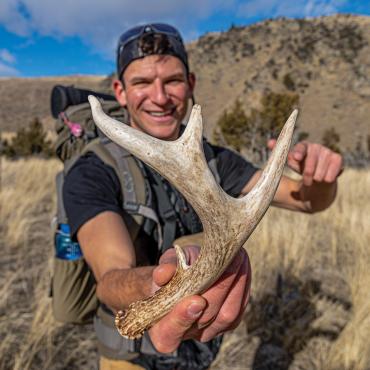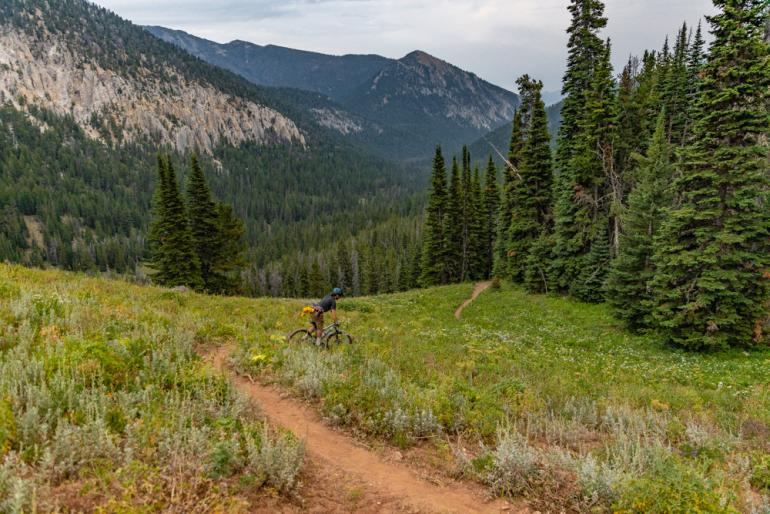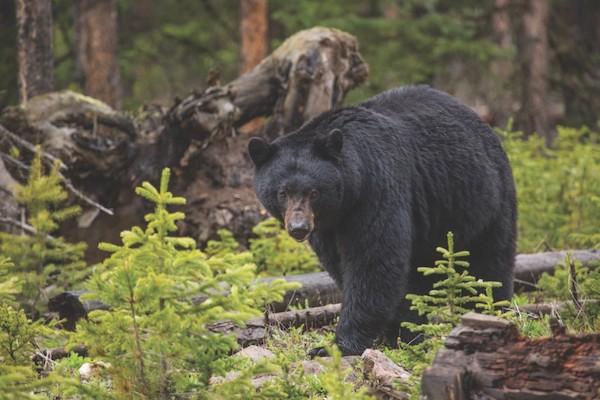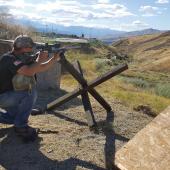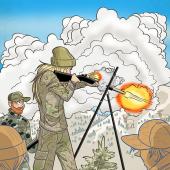Bearing Down
Hunting black bears on mountain bikes.
When I first established my Montana residency two years ago, I was startled, and pleasantly surprised, when I bought the Sportsman’s Pack of hunting licenses. The clerk handed me tags for species I never knew I could target—mountain lion, bobcat, coyote, bear. Bear? I confirmed with her. Yep, indeed, but I had to take a bear-identification quiz first. Twelve questions, with two possible answers for each: black or grizzly. I failed miserably. A week later, after squinting at dozens of photos of black bears with blonde coats and grizzly bears with black coats, I passed the test.
Until then, I’d never paid much attention to bears, beyond glancing at the ubiquitous, “You’re entering bear country” signs at every trailhead in southwest Montana. But, as an ambitious spring gravel-bike rider, I remembered seeing a couple of black specks meandering around the slopes in years past. They were usually pretty high up, plastered to the receding snowline, and always a long way from vehicle traffic, as most Forest Service roads in the region remain closed to motorized use until mid-June. Gears started turning in my head. What if I brought my rifle along next time?
Things had really greened up, and the balsamroot was now in full bloom, painting entire hillsides yellow.
Nearly all the mountain tracks around Bozeman were still snowed in, so I headed northwest, where my hunting buddy, Tom, said the arrowleaf balsamroot and wild onion were already poking through the damp spring soil. On a Saturday morning in mid-May, we pulled up to a relatively popular trailhead. Lashing rifles to packs and strapping on helmets, we navigated around a flock of moms out for a stroll, families getting weekend exercise, and too many day-hikers to shake a stick at. Needless to say, our blaze orange didn’t blend in too well. We received our fair share of dirty looks, but, much to the credit of Montanans, the only words actually spoken were, “Good luck out there!”
The crowds thinned after each bend, and by the 12-mile mark, we were the only ones leaving imprints on the freshly melted doubletrack. We hit a couple snow patches that we walked our bikes through, and eventually came across one we deemed impassable. We ditched the bikes and hit the slope on foot, aiming for a rocky knoll about 600 vertical feet above the road. I picked my way through thick clusters of shiny-leaf ceanothus (aka, snowbrush), which to me has always had an oppressive, claustrophobic smell. It was a startlingly hot weekend, almost 70 degrees, and the heat seemed to amplify the smell until it saturated the air and resonated with every breath. I imagine hell is choked with these plants, and the millions of ticks they harbor, too. Needless to say, I was relieved when we broke through these devil-bushes onto a rock outcropping.
It took a few minutes for the adrenaline to wear off, but once it did, we got to work quartering the animal and loading the chunks of dark red meat into our packs.
Tom and I set up our spotting scopes and nestled into shaded crags to wait out the afternoon. There was plenty of country to glass over. From our vantage, we could see deep into an old burn-scar above us, miles down the creek bottom below us, and had an unobstructed view of the grassy cliff bands on the far side of the river. It didn’t take long to start picking out bears. By evening, we were watching nine as they took erratic, looping paths across the slopes, gorging on wildflowers, flipping boulders, and chasing any movement that caught their attention. We laughed as these curious creatures scratched their backs on trees and a cub sent its sibling tumbling off a small cliff. Just before dark, we packed up and cruised out with headlamps, plans already in the making to return the next day.
I don’t remember why, but our plans got sidetracked—perhaps we were saddle sore, though I’m loath to admit it—and we didn’t make it back to that basin until three weeks later. Things had really greened up in the interim, and the balsamroot was now in full bloom, painting entire hillsides yellow. After a sweaty ride in, about a four-hour endeavor, we made for the same glassing knob. It was nearing the end of the hunting season, and, as a young, inexperienced hunter, I felt the pressure to shoot something. As such, I crept up to the pinnacle of the outcropping, in case there was a bear on the other side. Sure enough, there was a bruin picking his way through deadfall about 200 yards away.
The bear was across a small gulley, but about equal in elevation to me. A clear shot. I dropped my pack on the rock and dove into a prone position, taking just a few seconds to stabilize before squeezing the trigger. Nothing happened—the safety was on. I clicked it off, regained the bear in my scope, and squeezed again. It was a clean miss. The startled bear dove toward the creek bottom, plowing over logs and anything else in his way. He vanished into the thick of it, and my buddy and I stood scratching our heads, peering into the creek bottom for any sign of movement. Then, the animal broke from a thick patch of young Douglas fir (a Christmas-tree farm, as Tom calls it), about 20 yards away. He was still at a dead sprint. Doubtless, the bear had no idea I was there, and was just trying to make a quick getaway. I shouldered my gun, centered my scope on the animal barreling toward me, and dropped him with a shot to the chest at ten yards.
It took a few minutes for the adrenaline to wear off, but once it did, we got to work quartering the animal and loading the chunks of dark red meat into our packs. The trek out on bikes, though all downhill, was miserable with heavy packs. We cinched our shoulder straps tight, which, in a biking position, shifts most of the weight to your lower back. Painful, but far more bearable than on hunched shoulders. We received a number of comments—“nice one!” and “is that a bear?”— from the weekend mom crowd.
The next day, I took my pelt and skull into a Montana Fish, Wildlife & Parks office for a biologist to check it, as is required. Having noticed small nipples and a poky little bone in the pelvic region that I figured was a tail, I marked the “Female” box on the written form. Once the biologist opened up my pelt, he was quick to inform me that the bone was not, in fact, a tail. Rather, it was the creature’s penis—apparently bears have a bone there. It’s called a baculum. My animal was nonetheless a legal harvest, but it was a stark reminder that I’m still hard on the learning curve with these creatures. And, as I discovered on that first trip, their movements and behavior are far different from any ungulate roaming around the woods in Montana. Combine the challenge of a new species with the exercise of mountain biking; now there’s an activity that has made my list of annual springtime adventures.

